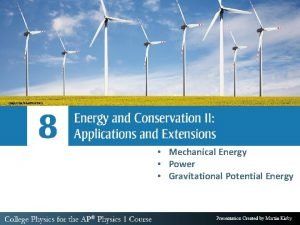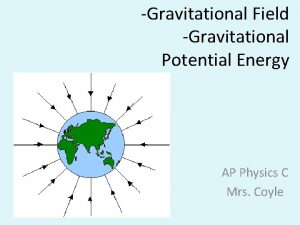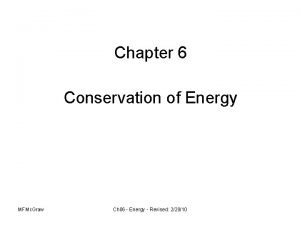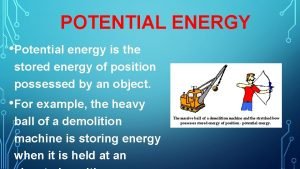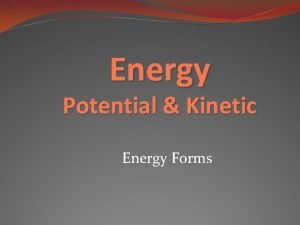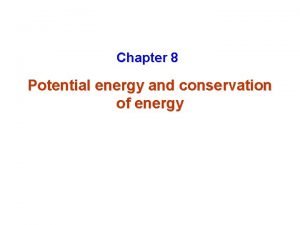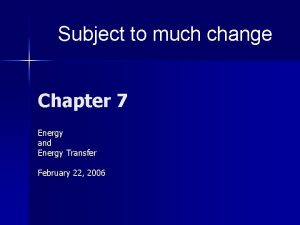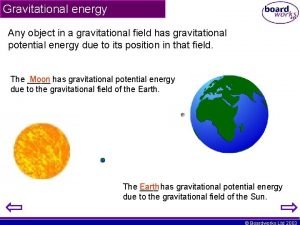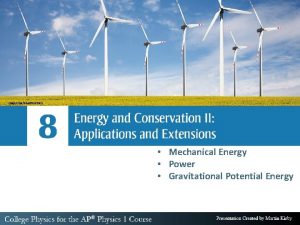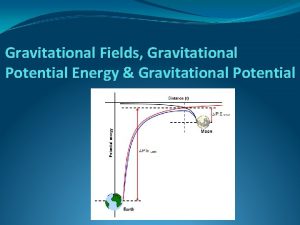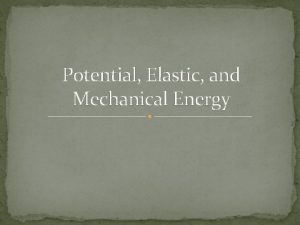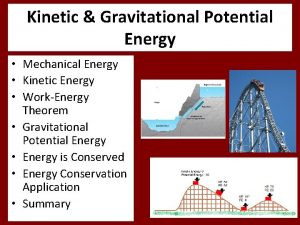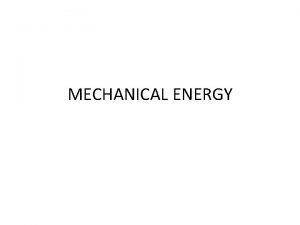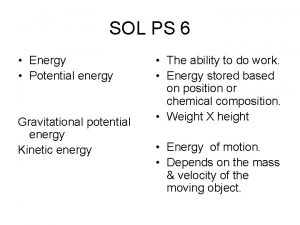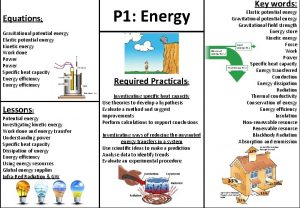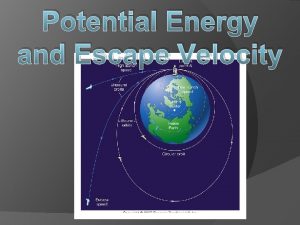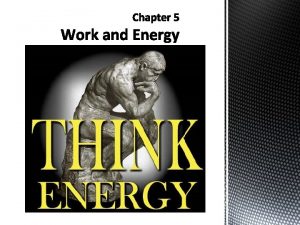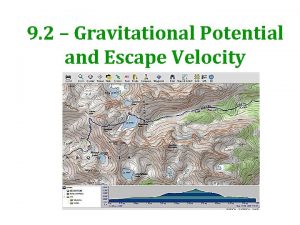majeczkaShutterstock Mechanical Energy Power Gravitational Potential Energy COLLEGE


























- Slides: 26

majeczka/Shutterstock • Mechanical Energy • Power • Gravitational Potential Energy COLLEGE PHYSICS FOR THE AP® PHYSICS 1 COURSE

Closed, Isolated Systems and Open Systems Closed, Isolated System Open System F 2 F 1 F 2 Matter cannot enter or leave a closed, isolated system. Its mass is constant. Energy cannot enter or leave a closed, isolated system. As always, energy can change from one type to another. The total energy of a closed, isolated system is constant. External forces cannot be exerted on a closed, isolated system. The net force on the system is zero. The net force in the system is zero. F 1 F 2 F 1 Matter can enter and leave an open system. Energy can enter and leave an open system. As always, energy can change from one type to another. External forces can be exerted on an open system. COLLEGE PHYSICS FOR THE AP® PHYSICS 1 COURSE

Is the system an open system, or a closed, isolated system? m m F F F battery m m battery An external force is Answer: A battery outside the Some mass leaves a Some mass enters a A battery inside the Two objects inside the Answer: The force is described exerted on the system makes a lamp system. Is the system attract each other. The system might be as ‘external’, which shine inside the system. Is The system is an system. Is the inside the system shine. a closed, isolated Is the system a closed, means that it is a closed, isolated open system. the system a closed, If no light leaves the isolated system or an open external to the system. isolated system or an open system, is the system a isolated system or open system? The system is an open system? closed, isolated system. an open system? system. or an open system? COLLEGE PHYSICS FOR THE AP® PHYSICS 1 COURSE

Total energy is constant only for a closed, isolated system. The Law of Conservation of Energy: Energy can be transferred from one object or system to another, or converted from one type into another but never destroyed Total energy is constant only for a closed, isolated system COLLEGE PHYSICS FOR THE AP® PHYSICS 1 COURSE

What is mechanical energy? Mechanical energy is energy that is associated with motion. K: Kinetic energy is a form of mechanical energy as kinetic energy is the energy of moving objects or systems. U: Potential energy is also a form of mechanical energy as all potential energy can be transformed into kinetic energy. COLLEGE PHYSICS FOR THE AP® PHYSICS 1 COURSE

Example of Mechanical Energy Being Conserved: The system is a block and a smooth ramp. There are no friction forces in this example. Wfriction = ∆Einternal = 0 In this case, potential energy is transformed entirely into kinetic energy. K + U g= E Einternal If a nonconservative force moves in a closed, isolated system, then mechanical energy, E, is not conserved. In this example, there is no nonconservative force such as kinetic friction. COLLEGE PHYSICS FOR THE AP® PHYSICS 1 COURSE

Example of Mechanical Energy Not Being Conserved: Co The system is a ns ta block and a nt sp rough ramp. ee d There are friction forces in this example. Wfriction = ∆Einternal In this case, potential energy is transformed into internal energy. K + U g= E Einternal If a nonconservative force moves in a closed, isolated system, then mechanical energy, E, is not conserved. In this example, the nonconservative force is kinetic friction. COLLEGE PHYSICS FOR THE AP® PHYSICS 1 COURSE

Work Done by Friction block Fk table on block table COLLEGE PHYSICS FOR THE AP® PHYSICS 1 COURSE

Problem (answer on next two slides) FN = 12. 0 N m= vf = ? vi = 5. 00 m/s 2. 00 kg d = 4. 00 m Fk table on block = 3. 00 N Fg = 12. 0 N This 2. 00 -kg object has an initial speed of 5. 00 m/s to the left A force of kinetic friction of 3. 00 N is exerted on the object. Calculate the speed of the object when it has moved 4. 00 m. COLLEGE PHYSICS FOR THE AP® PHYSICS 1 COURSE

Answer (Using the Object Model) If we use the object Vi = 5. 00 m/s FN = 12. 0 N model: The block is the Fk table on block = 3. 00 N An object. All the forces d = 4. 00 m Fg = 12. 0 cannot have on it are external so The friction force N potential do work. m =2. 00 kg is the only force energy (as an ∑W = ∆K + ∆U + ∆Einternal exerted along the object cannot ∑W = (Kfinal – Kinitial) + (0) direction of change Fkd cosθ = ½mvf 2 – ½mvi 2 motion. Work configuration) (3. 00 N)(4. 00 m)cos 180˚ = ½(2. 00 kg)vf 2 – ½(2. 00 kg )(5. 00 m/s)2 done by a kinetic and cannot 2 – 12. 0 N. m = (1. 00 kg)vf 2 – 25. 0 kg • m 2/sfriction force have internal – 12. 0 kg • m 2/s 2 + 25. 0 kg • m 2/s 2 = (1. 00 kg)vf 2 always dissipates energy. (1. 00 kg)vf 2 = 13. 0 kg • m 2/s 2 energy. vf 2 = 13. 0 m 2/s 2 vf = 3. 606 m/s relative to the table COLLEGE PHYSICS FOR THE AP® PHYSICS 1 COURSE

Answer If we use the system model: The block and the table are the system. (Using the System Model) Vi = 5. 00 m/s FN = 12. 0 N Internal interaction! The system is the table and the block. d = 4. 00 m Fg = 12. 0 N The kinetic friction interaction is internal m =2. 00 kg to the system, so can do no work. W = 0. ∑W = ∆E = ∆K + ∆U + ∆EThe internal energy of the system changes internal 0 = ∆E = (Kfinal – Kinitial)However, energy within a system can be + (Ufinal –(the block, table, and possibly the Uinitial) + ∆Einternal 0 = (½mvf 2 – ½mvi 2 ) +transformed from one form to another (0 – 0) +surrounding air warm up) when the |Fkd cosθ| 0 = (½(2. 00 kg)vf 2 – ½(2. 00 kg )(5. 00 m/s)2 ) + (0 – 0) + |(3. 00 N)(4. 00 m)cos 180˚| by internal interactions. Here some friction interaction is defined as internal 2/s 2 + 12. 0 N • m 0 = (1. 00 kg)vf 2 – 25. 0 kg • m kinetic energy is transformed into to the system. 2 0 = (1. 00 kg)vf 2 – 13. 0 kg • m 2 internal energy of the system. /s. It is the negative of the quantity F kd cosθ (1. 00 kg)vf 2 = 13. 0 kg • m 2/s 2 which is the work done on the block by vf 2 = 13. 0 m 2/s 2 the force of kinetic friction when the vf = 3. 606 m/s relative to the table interaction is outside of the system. COLLEGE PHYSICS FOR THE AP® PHYSICS 1 COURSE

Power is the rate at which energy is transferred into or out of a system or converted within a system P : Power (watt, W or J/s) ∆E : Total amount of energy being converted or transferred (joule, J) ∆t : Time over which that conversion or transfer occurs (second, s) COLLEGE PHYSICS FOR THE AP® PHYSICS 1 COURSE

J OUT: Thermal Energy 40 J/s Power = 40 W 40 J Efficiency = 50 j 1 s 50 joules IN: Electric Energy 50 joules/s Power = 50 watts 1 watt = 1 joule / second 50 joules Average Power= ∆E / ∆t 40 J OUT: Light Energy 10 J/s Power = 10 W 10 J 10 J 10 Useful power output 10 W = power input 50 W = 0. 2 = 20% COLLEGE PHYSICS FOR THE AP® PHYSICS 1 COURSE

Average power = work done / ∆time Calculate the power output of a motor if the motor takes 8. 00 s to raise an object of 4. 00 kg from rest to a speed of 12. 0 m/s over a height of 5. 00 m. motor 4. 00 kg average power = ∆E / ∆t P = ∆E / ∆t h = 5. 00 m v = 12. 0 m/s P = (∆Ug + ∆K) / ∆t P = ((Ug final – Ug initial) + ( Kfinal – Kinitial))/ ∆t P = ( (mgh – 0) + ( ½mvf 2 – 0)) / ∆t P = (mgh + ½mvf 2) / ∆t P = ((4. 00 kg)(10. 0 m/s 2)(5. 00 m)) + ((½)(4. 00 kg)(12. 0 m/s)2)/8 s 4. 00 kg P = (200 J + 288 J) / 8. 00 s h = 0. 00 m v = 0 m/s P = 488 J / 8. 00 s P = 61. 0 W COLLEGE PHYSICS FOR THE AP® PHYSICS 1 COURSE

Power = Fv cosθ v F d F : Magnitude of constant force (N) v : Magnitude of the velocity (m/s) θ : Angle between F and v COLLEGE PHYSICS FOR THE AP® PHYSICS 1 COURSE

Example Calculate the power provided by the 20 N force. F= 20. 0 N v = 3. 00 m/s d COLLEGE PHYSICS FOR THE AP® PHYSICS 1 COURSE

Question: A 4. 00 -kg box is being raised vertically at a constant speed of 5. 00 m/s by a rope. How much power is needed to do this? Let’s choose a time… say… 3. 00 s. Then in 3. 00 s the box will be raised a height of 15. 0 m. FT = mg Constant velocity of 5. 00 m/s 4. 00 kg Fg = mg COLLEGE PHYSICS FOR THE AP® PHYSICS 1 COURSE

Question: A 4. 00 -kg box is being raised vertically at a constant speed of 5. 00 m/s by a rope. How much power is needed to do this? The acceleration of the box is zero, so the net force on the box must be zero (∑F = ma). Therefore, the tension in the rope, FT, must be equal and opposite to the weight of the box, mg Constant velocity of 5. 00 m/s a = 0 ∑F = ma ∑F = m(0) ∑F = 0 FT = mg 4. 00 kg Fg = mg COLLEGE PHYSICS FOR THE AP® PHYSICS 1 COURSE

Gravitational Potential Energy 1 To move two objects apart, external forces must be used to overcome their force of gravity. Thus, work is done in changing the configuration of the system. As the force of gravity is a conservative force, the work done is stored as gravitational potential energy, Ug. m 1 r m 2 Ug : Gravitational potential energy of a system of two objects (J) G : Universal gravitational constant (Nm 2/kg 2) – 11 Nm 2/kg 2 G = 6. 67 × 10 m 1 : Mass of one object (kg) everywhere in the universe m 2 : Mass of the other object (kg) r : Center to center distance between the two objects (m) COLLEGE PHYSICS FOR THE AP® PHYSICS 1 COURSE

Gravitational Potential Energy m 1 r 2 m 2 Using this formula, the gravitational potential energy of this system is zero when the two objects are an infinite distance apart. Their gravitational potential energy is never positive. ∆Ug = mg∆y ∆Ug = (3. 00 kg)(10. 0 m/s 2)(2. 00 m) y 2 = 2. 00 m ∆Ug = 60. 0 J 3. 00 kg y = 0. 00 m 1 This formula only finds a change in gravitational potential energy. COLLEGE PHYSICS FOR THE AP® PHYSICS 1 COURSE

Gravitational Potential Energy m 1 r 3 m 2 This formula will always work. This formula works well only when the value of g has negligible change as one moves along h. COLLEGE PHYSICS FOR THE AP® PHYSICS 1 COURSE

Gravitational Potential Energy: Ug = –Gm 1 m 2/r r = m 1 v = 0 m/s m 2 Ug = – 600 J Ug = – 150 J Ug = – 40 J K = +600 J K = +150 J K = +40 J r E = K + Ug Gm 1 m 2 2 E = ½ m 2 v + (– ) r Gm 1 m 2 2 0 = ½ m 2 v + (– ) r Ug = – 5 J K = +5 J Note: Ug = 0 J K =0 J Gm 1 m 2 Ug= = 0 K = ½ m 2 v 2 = ½ m 2 (0)2 = 0 COLLEGE PHYSICS FOR THE AP® PHYSICS 1 COURSE

Question: Gravitational Potential Energy v = 0 m/s M now v = 0 m/s r 1 M M later v v r 2 M Two identical spherical objects of mass M are released from rest when their centers are a distance r 1 apart ( )). The objects then accelerate toward each other. now Show that when the spheres are a distance r 2 apart ( later ). COLLEGE PHYSICS FOR THE AP® PHYSICS 1 COURSE

Answer v = 0 m/s M M r 1 now As the total gravitational potential energy decreases, the total kinetic energy increases. M later v v r 2 M The system is the two objects. COLLEGE PHYSICS FOR THE AP® PHYSICS 1 COURSE

r. A mp A Escape Velocity B mball At what speed would a ball have to be thrown from the surface of a planet of mass mp and radius r v that it just arrives at infinity? What goessoup must come The system is the down… is this true? Earth and the ball. Throw a ball away from the What goes up must come surface of the planet at a speed down… thisthe true? equal to, or greateristhan, escape velocity of planet, and v is known as the escape velocity it will never come down. COLLEGE PHYSICS FOR THE AP® PHYSICS 1 COURSE

Chapter 8 Summary A single object can only have kinetic energy. Systems have kinetic energy, potential energy, and internal energy. Nonconservative forces can transform mechanical energy into internal energy. Power is the rate at which energy is transferred into or out of a system or converted within a system. Average P = ∆E/∆t Gravitational potential energy Ug = –Gm 1 m 2/r, where Ug is zero at infinity when the two objects are an infinite distance apart. COLLEGE PHYSICS FOR THE AP® PHYSICS 1 COURSE
 Kinetic energy gravitational
Kinetic energy gravitational Gravitational potential energy vs kinetic energy
Gravitational potential energy vs kinetic energy How is potential energy used
How is potential energy used Gravitational potential energy
Gravitational potential energy Gravitational potential energy
Gravitational potential energy Work done by normal force
Work done by normal force What is potential energy
What is potential energy Form of energy
Form of energy Gravitational potential energy
Gravitational potential energy Gravitational potential energy
Gravitational potential energy Si unit of potential energy
Si unit of potential energy Kinetic energy equation
Kinetic energy equation Gravitational potential energy
Gravitational potential energy Kinetic energy and potential energy formula
Kinetic energy and potential energy formula How to increase potential energy
How to increase potential energy Power energy relation
Power energy relation Light energy examples
Light energy examples Electric potential isolines
Electric potential isolines Units of electric potential energy
Units of electric potential energy Electric potential vs electric potential energy
Electric potential vs electric potential energy V=pe/q
V=pe/q What is mechanical energy
What is mechanical energy Actual power and potential power
Actual power and potential power Draw the power triangle
Draw the power triangle Energy example
Energy example Kinetic and potential energy
Kinetic and potential energy Kinetic energy and potential energy
Kinetic energy and potential energy


